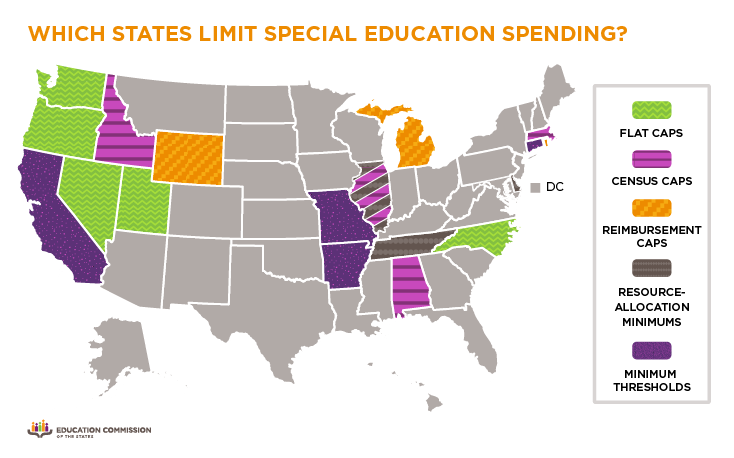In times of limited financial resources, states look for ways to rein in spending. Unfortunately for state education policymakers, times of limited financial resources are becoming more and more common. Special education expenditures can often be volatile, fluctuating from one year to the next, because of changing student demographics. To limit state costs and increase predictability, at least 18 states cap special education funding or require districts to reach a minimum threshold before they are eligible for additional funding.

It is important to note that these limitations only apply to state spending. Under the federal Individuals With Disabilities Education Act, a combination of local, state and federal funding must fully cover the cost of providing the services outlined in a student’s Individualized Education Program. By limiting state funding, states are shifting the special education funding burden to localities.
The percentage of students who require special education services varies from district to district and from school to school. Generally, districts near hospitals and military bases have higher percentages of identified students so that they can be closer to available services. When states use statewide averages or caps to rein in special education spending, it does not accurately reflect the costs incurred by the districts.
There are five ways that states limit special education expenditures: flat caps, census caps, reimbursement caps, resource-allocation minimums and minimum thresholds. (For more on which states employ these caps, see our new 50-State Comparison.)
- Flat Caps: The state places a limit on the percentage of students that can be identified as requiring special education services. Example: Oregon provides an additional 100 percent of funding for each student identified as requiring special education services. However, a district may only receive additional funding for up to 11 percent of its students.
- Census Caps: The state assumes that a flat, statewide percentage of students require special education services, regardless of the actual demographic makeup of a district or school. Example: Alabama assumes that 5 percent of all students in the state require special education services. It then provides each district in the state with an additional 150 percent of funding for those 5 percent of students.
- Reimbursement Caps: The state reimburses districts for a certain percentage of their special education expenditures. Example: In Michigan, district special education expenditures are reimbursed by the state. However, the reimbursement rate to districts cannot exceed 75 percent of the total approved costs of operating special education programs.
- Resource-Allocation Minimums: The state requires a district to meet a minimum requirement, usually a minimum number of identified students, before the state provides that district with funding for special education services. Example: Delaware funds special education services through a resource-allocation model. Under this model, a mainstream, fourth-grade classroom has a teacher-student ratio of 1-to-20. For a basic special education classroom, the teacher-student ratio is 1-to-8.4. However, if a school or district has fewer than 8.4 students who require special education services, it often receives no additional funding (in the form of a higher teacher-student ratio).
- Minimum Thresholds: The state provides funding to districts for only high-cost special education services. The cost must exceed a certain threshold. Example: In Connecticut, a district is responsible for all costs up to 4.5 times the average per-pupil educational costs. If a student’s special education services cost less than that, then the district receives no additional funding.
Understandably, states are working to limit costs and increase predictability in special education spending. While caps and minimum thresholds control spending at the state level, it shifts the funding burden to districts. Policymakers can work to ensure that among shifting fiscal responsibility, students’ needs continue to be met.
Earlier this week, we outlined the trends that are being proposed in special education funding mechanisms this legislative session. You can see it here.







